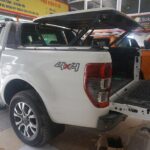Undercoating low chassis trucks is a method to protect the undercarriage from harmful environmental factors. However, whether it’s necessary for this type of vehicle is a question many are interested in. This article will analyze 9 facts about undercoating low chassis trucks that you should know.
1. Do Low Chassis Trucks Need Undercoating?
Low chassis trucks are often used in harsh conditions, traveling on various terrains. The undercarriage is easily affected by rocks, gravel, dirty water, road salt, etc., causing rust, scratches, and damage. Therefore, undercoating is a necessary solution to protect the undercarriage of low chassis trucks.
Close-up of a low chassis truck undercarriage showing susceptibility to road conditions.
2. Benefits of Undercoating Low Chassis Trucks
Undercoating low chassis trucks offers many benefits:
- Rust prevention: The coating protects the undercarriage from water, salt, chemicals, etc., preventing oxidation and rust.
- Corrosion resistance: Prevents metal corrosion caused by environmental factors.
- Scratch protection: Protects the undercarriage from impacts with rocks, gravel, and road debris.
- Noise and heat insulation: Reduces noise from the undercarriage and limits heat transfer into the cabin.
- Easy cleaning: The smooth coated surface makes it easy to clean and remove dirt and mud.
3. Best Time to Apply Undercoating
It is recommended to undercoat low chassis trucks immediately after purchase or when the undercarriage shows signs of rust or scratches. Early undercoating provides better protection, prevents damage, and extends the vehicle’s lifespan.
A new low chassis truck, emphasizing the recommendation for immediate undercoating after purchase.
4. Long-Term Effectiveness
The undercoating layer on low chassis trucks is typically effective for about 3 years. However, the lifespan of the coating can be extended with proper maintenance and use under ideal conditions.
5. Noise and Heat Insulation
Undercoating acts as sound and heat insulation, helping to minimize noise from the undercarriage and reduce heat transfer into the cabin, creating a comfortable environment for the driver.
6. Prevents Undercarriage Deformation
Undercoating helps limit undercarriage deformation due to impacts, protecting important components underneath the vehicle.
Undercoating protecting the truck undercarriage from impacts and debris.
7. Easier Undercarriage Cleaning
Undercoating creates a smooth surface on the undercarriage, making it easier to clean and remove dirt and mud that adheres to the undercarriage.
Washing a low chassis truck undercarriage, demonstrating the ease of cleaning after undercoating.
8. Popular Undercoating Methods
Currently, there are 3 popular undercoating methods: using chemicals, CO2 compression, and undercoating paint. Each method has different advantages, disadvantages, and costs.
9. Choosing a Reputable Undercoating Service
To ensure the quality and effectiveness of undercoating, it is important to choose reputable undercoating services with experience and high-quality materials.
Professionals applying undercoating to a low chassis truck in a service bay.
Undercoating low chassis trucks is an effective solution to protect the undercarriage, increase the vehicle’s lifespan, and improve operational efficiency. Consider and choose the undercoating method that best suits your needs and operating conditions.
